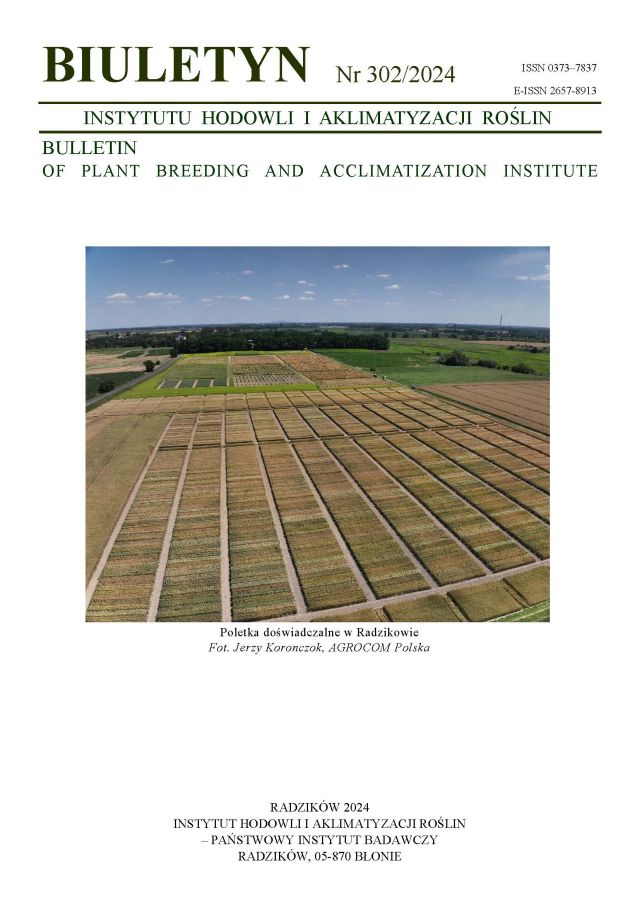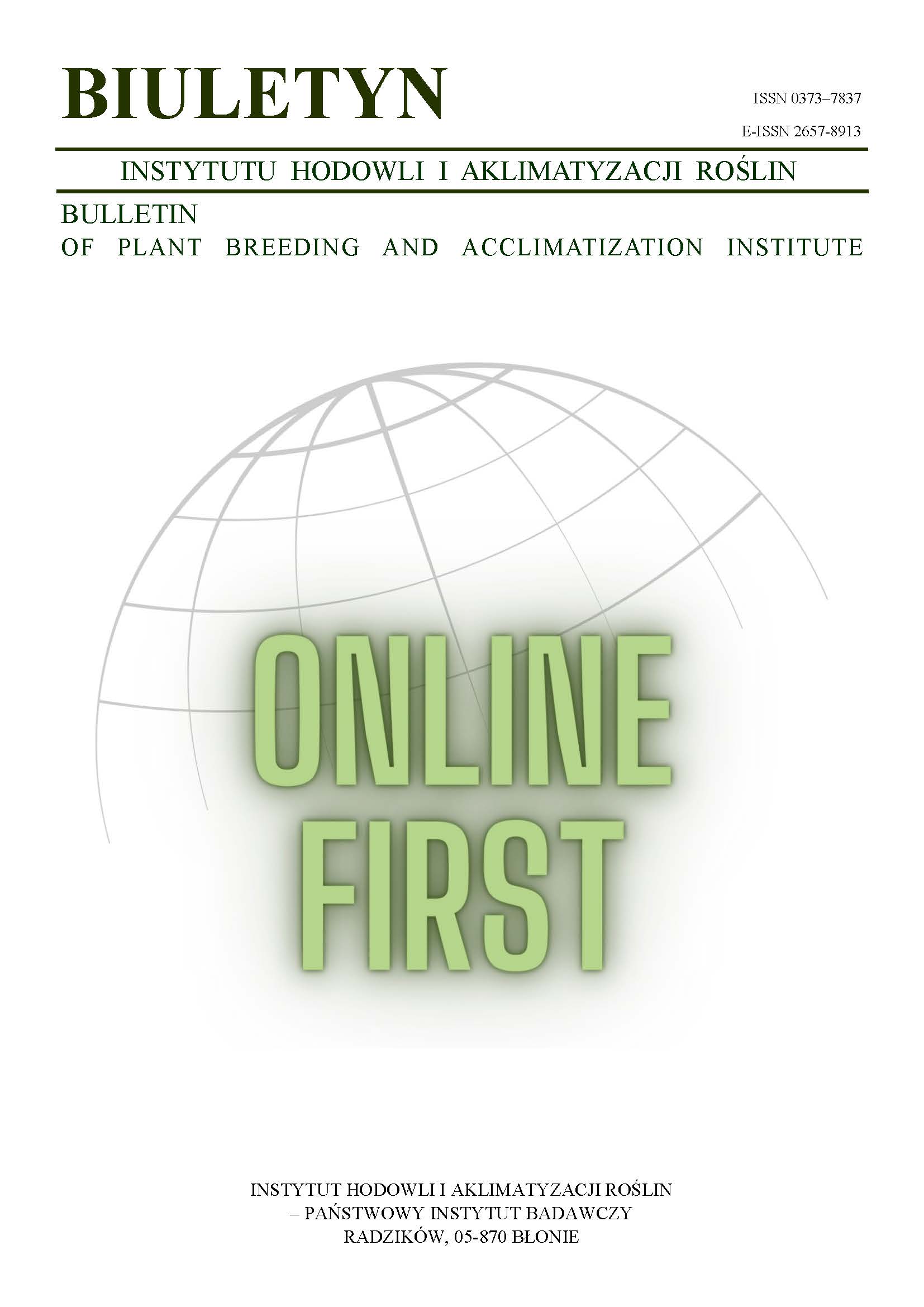The susceptibility of Colorado potato beetle larvae from different regions of Poland to some insecticides in laboratory tests of the year 2002
Elżbieta Przybysz
ipo@ipo.lukasiewicz.gov.plInstytut Przemysłu Organicznego, Warszawa (Poland)
Maria Pawińska
Zakład Nasiennictwa i Ochrony Ziemniaka w Boninie, Instytut Hodowli i Aklimatyzacji Roślin w Radzikowie (Poland)
Stefan Pruszyński
Instytut Ochrony Roślin, Poznań (Poland)
Paweł Węgorek
Instytut Ochrony Roślin, Poznań (Poland)
Marek Mrówczyński
Instytut Ochrony Roślin, Poznań (Poland)
Abstract
The susceptibility level of Colorado potato beetle (CPB) larvae (Leptinotarsa decemlineata Say) to insecticides most often used in Poland was studied. Bancol 50 WP (a.i. bensultap), Decis 2.5 EC (a.i. deltamethrin), Karate 025 EC, (a.i. λ-cyhalothrin) and Fastac 100 EC (a.i. α-cypermethrin) were tested. In the laboratory tests, the standard dipping method was used as recommended by the Insecticide Resistance Action Committee (IRAC method no. 7). Bioassays of insecticide for resistance monitoring were performed in central, northern and western regions of Poland (Institute of Industrial Organic Chemistry in Warsaw, Plant Breeding and Acclimatization Institute in Bonin and Institute of Plant Protection in Poznań, respectively). The susceptibility level was expressed by percent of mortality. The susceptibility of larvae to pyrethroids was lower in some localities of the central and northern regions, and for bensultap it was locally lower in all the tested districts.
Keywords:
bensultap, Leptinotarsa decemlineata Say, Colorado potato beetle, monitoring, pyrethroids, susceptibility levelReferences
Pawińska M., Mrówczyński M. 2000. Występowanie i zwalczanie stonki ziemniaczanej (Leptinotarsa decemlineata Say.) w 1978–1999. Prog. Plant Prot. 40, 1: 292 — 299.
Google Scholar
Węgorek P., Pruszyński S., Kroczyński J., Szczęsna E. 1988. Zmiany we wrażliwości stonki ziemniaczanej (Leptinotarsa decemlineata Say.) na chlorfenwinfos w Polsce w świetle badań 1987 r. Materiały 28 Sesji Nauk. IOR. Cz. I: 185 — 201.
Google Scholar
Przybysz E., Pawińska M., Węgorek P. 1996. Monitoring odporności stonki ziemniaczanej na niektóre stosowane w Polsce insektycydy. Prog. Plant Prot. IOR. 36, 1: 338 — 342.
Google Scholar
Węgorek P., Przybysz E., Kroczyński J., Morytz B. 1999. Znaczenie monitoringu odporności owadów na insektycydy na przykładzie stonki ziemniaczanej. Prog. Plant Prot. 39, 1: 351 — 359.
Google Scholar
Authors
Elżbieta Przybyszipo@ipo.lukasiewicz.gov.pl
Instytut Przemysłu Organicznego, Warszawa Poland
Authors
Maria PawińskaZakład Nasiennictwa i Ochrony Ziemniaka w Boninie, Instytut Hodowli i Aklimatyzacji Roślin w Radzikowie Poland
Authors
Stefan PruszyńskiInstytut Ochrony Roślin, Poznań Poland
Authors
Paweł WęgorekInstytut Ochrony Roślin, Poznań Poland
Authors
Marek MrówczyńskiInstytut Ochrony Roślin, Poznań Poland
Statistics
Abstract views: 45PDF downloads: 23
License
Copyright (c) 2004 Elżbieta Przybysz, Maria Pawińska, Stefan Pruszyński, Paweł Węgorek, Marek Mrówczyński

This work is licensed under a Creative Commons Attribution-ShareAlike 4.0 International License.
Upon submitting the article, the Authors grant the Publisher a non-exclusive and free license to use the article for an indefinite period of time throughout the world in the following fields of use:
- Production and reproduction of copies of the article using a specific technique, including printing and digital technology.
- Placing on the market, lending or renting the original or copies of the article.
- Public performance, exhibition, display, reproduction, broadcasting and re-broadcasting, as well as making the article publicly available in such a way that everyone can access it at a place and time of their choice.
- Including the article in a collective work.
- Uploading an article in electronic form to electronic platforms or otherwise introducing an article in electronic form to the Internet or other network.
- Dissemination of the article in electronic form on the Internet or other network, in collective work as well as independently.
- Making the article available in an electronic version in such a way that everyone can access it at a place and time of their choice, in particular via the Internet.
Authors by sending a request for publication:
- They consent to the publication of the article in the journal,
- They agree to give the publication a DOI (Digital Object Identifier),
- They undertake to comply with the publishing house's code of ethics in accordance with the guidelines of the Committee on Publication Ethics (COPE), (http://ihar.edu.pl/biblioteka_i_wydawnictwa.php),
- They consent to the articles being made available in electronic form under the CC BY-SA 4.0 license, in open access,
- They agree to send article metadata to commercial and non-commercial journal indexing databases.
Most read articles by the same author(s)
- Józefa Kapsa, Marek Mrówczyński, Tomasz Erlichowski, Hanna Gawińska-Urbanowicz, Konrad Matysek, Jerzy Osowski, Maria Pawińska, Janusz Urbanowicz, Sławomir Wróbel, Potato protection according to the principles of integrated pest management. Part II. Sustainable method of chemical potato protectio , Bulletin of Plant Breeding and Acclimatization Institute: No. 273 (2014): Regular issue
- Józefa Kapsa, Marek Mrówczyński, Tomasz Erlichowski, Hanna Gawińska-Urbanowicz, Konrad Matysek, Jerzy Osowski, Maria Pawińska, Janusz Urbanowicz, Sławomir Wróbel, Potato protection according to the principles of integrated pest management. Part I. Non-chemical methods of protection , Bulletin of Plant Breeding and Acclimatization Institute: No. 273 (2014): Regular issue
- Janetta Niemann, Małgorzata Jędryczka, Joanna Majka, Marek Mrówczyński, Joanna Kaczmarek, Dorota Weigt, Introduction of disease and pest resistance genes and male sterility from Brassica relatives to rapeseed (Brassica napus L.) , Bulletin of Plant Breeding and Acclimatization Institute: No. 286 (2019): Special issue














